

15 June 2022. We travel by local bus. The driver has the sun visor down. It’s easy to see what’s important to him: his grandchildren are all there, right where he can see them.
The bus takes us from Adamantas to the bottom of Plaka, which sits at the top of a cliff. Memories of our time there fade, but I know that we get off the bus and walk. We use maps, but don’t really know where we’re going. All we know is that it’s up.
As we follow the alleyways and staired lanes moving ever higher the town seems to crumble around us. We begin in what I learn later is a “new” town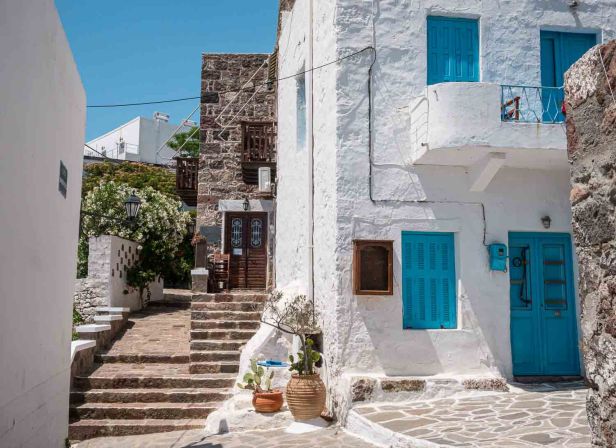

but as we climb higher there are more and more indications this is an ancient place – a crumbling stone wall here, an abandoned and unkempt home there,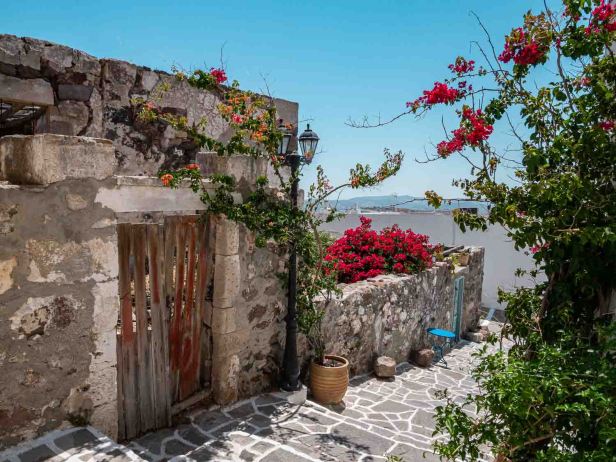
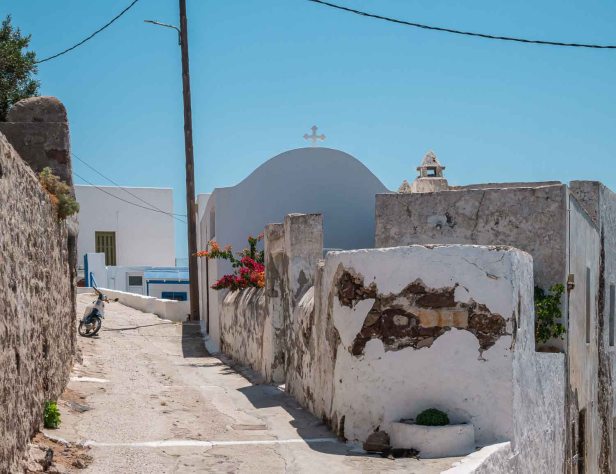
a long neglected small garden with a pot or two of tenacious plants, broken pots,
disintegrating walls. Not a sense of despair so much as a feeling of being a little left behind, perhaps neglected.
The remains of the13th century Venetian fortress is the only thing in Milos that bears testimony to Venetian rule. It was a peaceful and productive time enriched by farming and mining. Then pirates came, and Greek Buccaneers, along with venereal diseases and general dissolution, but trade still created a high standard of living. The Turks defeated the Venetians, and evicted the Buccaneers. Muslim pirates raided stole raped slaughtered. 1703 the plague entered the scene. 1706 a volcanic eruption. Five years later another. In 1738 a powerful earthquake. The island was reduced to a time of filth, noxious pollution, destroyed buildings. By the end of the 18th century the original town was abandoned, the residents moved into the castle and built a new village by stripping the old buildings. Eventually there was not enough room within the castle walls so the residents built a village next to it. This is the town of Plaka.
Plaka, the capital of the Cycladic island of Milos, sits atop the cliff with a view as wide as the sky, as wide as your imagination, or mine,
and topped by the ancient Venetian stronghold. Climbing higher and higher we come to the final ascent.
From the top all potential disturbance could be detected by the Venetians long before it became a real threat. We are on top of the world!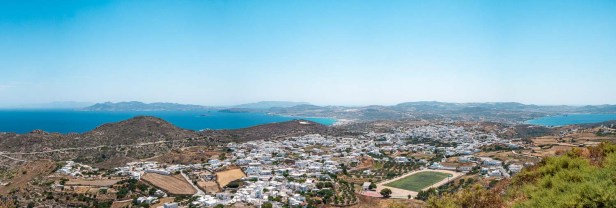
Hot. Enervated. Thirsty. Sun beating down. No shade, no breeze. We make our way down and collapse into the first inviting place we come to. Aaaaaahhh shade, a cold drink, a seat for weary legs, a time to inhale and exhale without wanting to achieve anything. We sit for a while, almost motionless.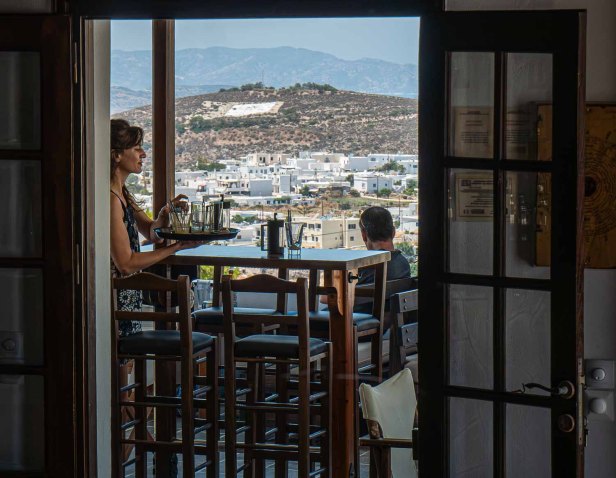
Eventually it’s time to move again. Making our way further down we somehow find the trail. As usual maps.me guides us, otherwise how would we have ever found it? In retrospect I’m not entirely sure how I even found out about the walk we embark on. All we know is that there’s a tiny local trail from Plaka down to the water; a trail from the top of the cliff to the sea below and the utterly irresistible fishing village of Klima; a trail that has been used by the people of the two villages for generations.
We follow what’s left of the flagstone paving, overgrown with weeds, bordered by centuries old stone walls, and likely equally old olive trees.

It’s a treasure hunt finding the way, an endless search for an indication of the trail’s direction. It is teasing us, challenging us to discover it. Is it this way? Or that way? Look at the map again. In some parts the trail is almost hidden.
We pass a small church,
and at about the halfway point look back up to where we’ve come from; Plaka at the top of the cliff.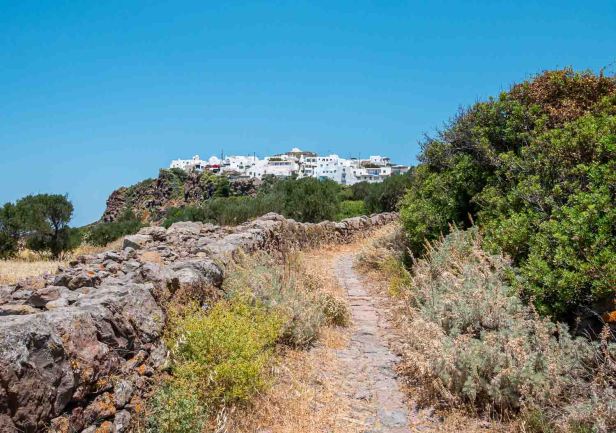
We walk towards Profitis Ilias Chapel sitting high on its own hill,
as our feet tread the narrow path, following in the footsteps of so many before us, centuries of people connecting from village to village up and down the cliffside.
We come unexpectedly to a wide open space with no indication of where to go next,
but crossing it we find the way. We are closer to the sea now.
There’s a sign indicating the way to the ancient Roman amphitheatre but we choose not to go there; I’m pulled relentlessly towards Klima, and if you could see around this bend
you would see a long steep stone staircase that leads right down to the water; and to the road that in these modern times connects the two villages with each other and with the rest of the island; and to Astakas Restaurant, the only restaurant in Klima. It is our first stop.
A meal, a drink, a rest for weary legs, shade, a cool breeze. We are revived by all this, and it’s time to explore Klima, this bright enticing ribbon of colour spread along the shore.
It is the epitome of Cycladic folk architecture, and the most iconic of Milos’ fishing villages. These small fishers’ houses, called syrmata, comprise boat storage beneath and a home above. The boat is dragged into the front of the sea-level area for protection against harsh weather; the rear is a cave dug into the volcanic rock – a storehouse for fishing and boat-maintenance gear. The bright colours are so the fisherman can see his house from a distance, and also to use the paint left over from painting his boat. The syrmata date from the 1800’s after the newly-founded Greek state was liberated from the Ottomans. People turned to activities like mining, agriculture, and fishing, and during this time the fishermen living in Klima built their small boat garages. Some are still used this way; many have been turned into a boutique, or rental accommodation unique to Milos.
We are worlds away from all we’ve seen of the Cyclades; worlds away from the typical sugar-cube architecture; worlds away from the usual labyrinth of streets. This is something different. We have arrived at some kind of fairyland, a magical place, a song of colour, and I’m reminded of the same bright joy of the coloured houses of Burano.

I want to see everything! We walk from one end to the other and back, past the syrmata, some open, most closed; past the concrete breakwaters; past the small beach.

My enchantment never fades.

I want to know everything – do people still live here? How do they live? What can I know about their unique lives that are so different and so the same as mine – the moods, the feelings, the hard work, the rest, the restlessness, the contentment? I peer into open doorways trying to divine the interior – of the home, and of the person who lives there or owns it. To live in such a place is so far beyond my own experience that I can barely imagine it.


How delightful that people got to live like this, between the bright colours and the shining sea, and that some still do; in a tiny house with the blue water as their front garden and the mountain at their back. I call it magical, and for me it is; it’s so bright; it’s so exotic.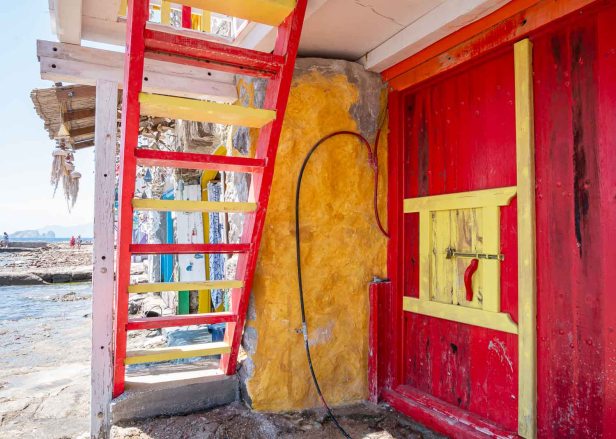
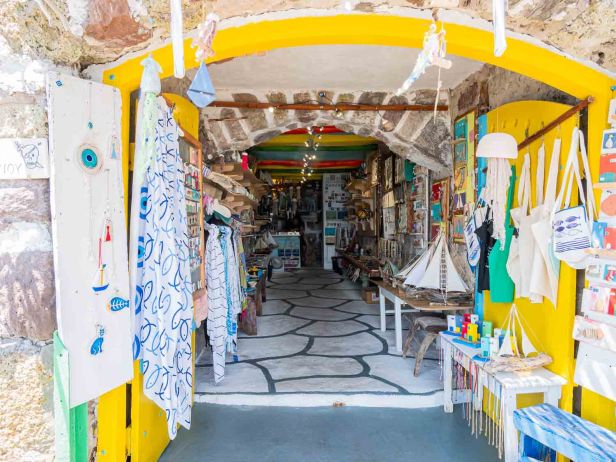
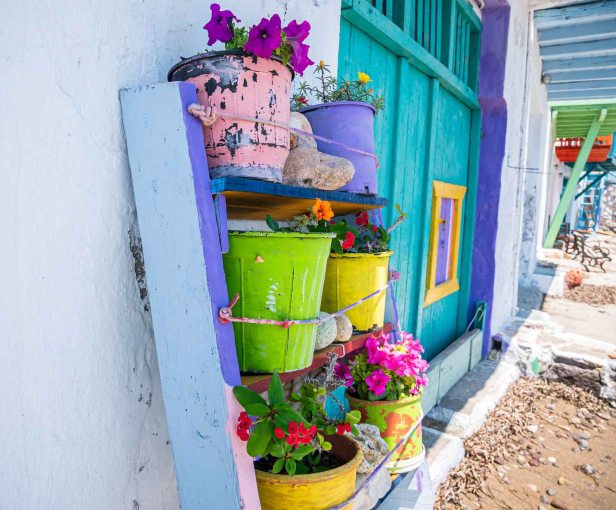
But on a more prosaic note it is no doubt ordinary for the people who still make a living from the sea, who still fish and live in the tiny house above the boat garage; work eat sleep dream rest work eat sleep; so different yet so the same.
A day later we return by boat and see the vivid panorama of Klima from the sea, with Plaka above on the right, and Profitis Ilias Chapel high on the hill on the left.


We make a foolish decision. Well perhaps not foolish so much as not well thought out; it amounts to the same thing. We decide to walk back up to Klima via the road. Hot. Steep uphill. Really hot. Dying from the heat. Relentlessly uphill. No shade anywhere. No sidewalks. Traffic. What were we thinking?

At last we reenter Plaka, and by following the winding streets,
come at last to the centre of the “new” old town where there is shade, and cafes, and cold drinks, and ice cream,

and a notice board displaying some really really faded real estate notices. I idly wonder if any of the places listed ever sold.
On the bus back to Adamantas a glimpse of the ancient windmills of Trypiti, the village just a little down the hill from Plaka.
As I write this it occurs to me, and astonishes me, that we didn’t think to look into a bus from Klima back to Adamantas. Of course there is one . . . . .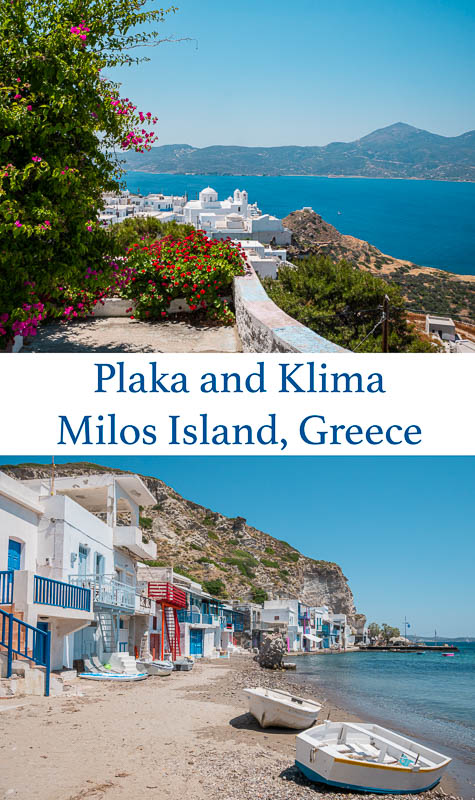
Next post: That boat trip I mentioned: a day on the water circumnavigating Milos Island. One of our best days, and the last of the posts about Greece.
All words and images by Alison Louise Armstrong unless otherwise noted.
© Alison Louise Armstrong and Adventures in Wonderland – a pilgrimage of the heart, 2010-2023.

“and the last of the posts about Greece.” – But I don’t want to leave Greece! Can’t we stay just a little bit longer? 😛
I kept getting distracted from the gorgeous views in this post by thinking “and what Alison is not saying is that everything is hot, sweaty, broken by these moments of “ah, this is why we’re putting ourselves through this” to keep going.”
Course, that could be because we’re in the middle of a heat wave (107 F today. 107!!) here in OK and everything remotely related to hiking sounds too hot to bother with. Even if you do end up on top of the world!
Favorite picture in this one is the 2nd one from the top – I like the front, middle, and back being all different (flowers, white buildings, blue water) and the different colors. I could sit there – in the SHADE – and read a book for hours.
LikeLiked by 1 person
Oh yes, it was really hot and sweaty, but the views were amazing, and then we’d get to a place to stop and get out of the sun and have a cold drink. It was so worth it, both the climb to the top and the hike down to Klima. But yeah – really hot and sweaty *especially* coming back up the road. That was nuts.
I didn’t want to leave Greece either, and hope to go back one day.
Your fave pic is also one of mine for the same reasons – such a beautiful place.
Alison
LikeLike
Hi you two. Marvelous geography and architecture. 🙂
LikeLiked by 1 person
Hi Paulette! Greece is such a beautiful country. We loved it.
Hope you’re both well (and the dogs too of course!).
Don is *much* improved. Will post an update soon.
Alison
LikeLike
Hi Alison. Thankfully we’re well and survived the storm and Ojai earthquake (epicenter 3 miles from our home). Always so nice to see your posts and have a little back and forthl. xox Paulette
LikeLiked by 1 person
I had no idea about the earthquake! That must have been scary, especially being so close. *And* a storm. You have been going through it. I’m glad to hear you survived it all.
Yes, always lovely to connect. It must be over 10 years now!
A.
LikeLike
Yes, at least ten years. All memorable. Safe travels and be well you two. ❤️
LikeLiked by 1 person
I love your descriptions, Alison. “song of color” – who would think of that, and yet I can see it exactly. Love reading about and seeing your adventures.
LikeLiked by 1 person
Thanks so much Kay. I’m so glad you’re enjoying the blog. I still have fun doing it. Writing can at times be challenging, but sometimes I actually get inspired. That always feels like a bonus.
Ali xo
LikeLike
The scenery is amazing, but I especially liked seeing the pic with the bus driver and his grandchildren.
LikeLiked by 1 person
Ah yes, Greece is so beautiful; gorgeous scenery every where we went.
The pic of the bus driver was a lucky shot – I had no idea about the grandchildren until I processed it in Lightroom. So lovely. Not hard to tell where his heart lies.
Alison
LikeLiked by 1 person
:Lucky shots are great rewards.
LikeLiked by 1 person
Fabulous photos as usual – thank you for sharing and inspiring.
LikeLiked by 1 person
Thanks so much Alison. I’m glad you enjoyed it. Greece is so beautiful. I’d love to go back.
Alison
LikeLiked by 1 person
The views from this post and your series of photos are something else, Alison ~ a bit of heaven with the blue skies and sea surrounded by such a peaceful town (even with the crumbling…), so different from its chaotic history. All made more special with your finding the lesser-worn path to view the area and invite in an adventure or two 🙂 Klima seems like a little paradise, with beautiful descriptions and photos. Such a wonderful post – makes me look forward to the day I travel there 🙂
LikeLiked by 1 person
Thanks so much Dalo. 🙏 I was a bit astonished by the history of Milos – seems it went through everything!
Finding that little path down to Klima was a treat – it felt like a goat trail, or like supplies would be taken down by donkey, but there’s nothing online about it, only that it’s there. And Klima was an absolute gem.
I’m so glad you enjoyed the post. We loved Milos. I hope you get there!
Alison
LikeLike
I want a new house in a new town after all these posts! White with blue-green doors. Wide flagstone steps leading up to it. Ocean views all around. Ancient stone walls, dirt paths, fresh-air restaurants. The dream lives on … 🙂
LikeLiked by 1 person
Wouldn’t mind a house like that myself 😂 especially the ocean views part. Ah, we can dream right?! 🤗
Alison
LikeLiked by 1 person
Plaka looks interesting, and Klima endlessly charming. And the views from the island itself are spectacular. It’s amazing what those Greek islands have to offer, and it’s great that you went to different parts of the Cyclades to get a better sense of each of them. I really don’t want your post series from Greece to end, Alison.
LikeLiked by 1 person
The Cyclades was just about our overall favourite of our whole 7-week trip through Croatia and Greece. It’s for sure a very special part of the world, and I’m glad we chose the islands that we did. Santorini was an obvious choice, and Milos, our fave, was recommended by a friend.
All things must pass Bama 😁 any further posts beyond the next one would be fictional 😂 though I will do a photo essay of people – been saving the best of the street photography that didn’t make it into a post.
Alison
LikeLiked by 1 person
Loved reading this, Alison. Your writing is engaging and I felt like I was sweating right along with you. 🙂 The first hike’s reward of charming Klima with its colorful buildings was a treat to see. A big shock when you decided to make the climb again, but that’s makes for great travel memories! Thanks for sharing this wonderful experience.
LikeLiked by 1 person
Thank you so much! Klima was such a magical reward after the hike down – as wonderful as I expected/hoped it would be. As for the climb back up – that was just silly, especially as there are some ancient catacombs 4 mins walk up from Klima right by the bus stop back to Adamantas. Oh well, we still had a pretty good day.
Alison
LikeLiked by 1 person
Those colors! Nobody can accuse the Greeks of being a drab people. Were their characters as bright?
LikeLiked by 1 person
Aren’t they wonderful! I loved Klima. And all the Greek people we met were lovely.
Alison
LikeLiked by 1 person
Alison, kudos for finding the trail down to Klima – judging by the photos, it seems you and Don were the only ones on it! Compared to the long hike you did on Santorini, this one feels a lot more secret. Had we been there, I think Bama and I would definitely have taken the detour to the Roman theater. 😂 But Klima is undoubtedly the star of the show… those colors surprised me and I was struck by how smart the fishermen were to build the boat garages at sea level and dig out caves for storage. Also, I can’t get over the flawless clear skies you encountered; some of your pics look like they belong in a glossy travel magazine!
LikeLiked by 1 person
Seen one Roman amphitheatre seen ’em all 😂 but I do wish we’d gone to the early Christian catacombs just 4 mins walk from Klima, and gotten the bus back from there. Usually we’re better with research!
It did feel like a secret trail for sure, and that’s my favourite kind; we *were* the only ones on it.
For sure Klima was the star of the show – I just loved it. It reminded me a little of the fishermen’s houses in Ine, Japan – arrayed along the water the same, though a complete different style of architecture of course.
The sky in Greece was so beautiful, and we really lucked out with the weather.
I wish my pictures were in a glossy travel magazine 😂
Alison
LikeLike
This is such a great post with so many beautiful and colourful photos. When it comes to beautiful places, Greece ticks many boxes. You could be captivated by wildflowers growing around ancient temples, or the graceful architecture of Venetian towns, the legacy of Venetian rule here. Perhaps the medieval majesty of Rhodes will be your lasting memory or the impossibly pretty port of Hydra. Thanks to your inspiring blog post, Klima, with its long strip of multi-coloured traditional fishermen’s houses has now made its way onto my travel wish list. Cheers 🙂 Aiva xx
LikeLiked by 1 person
Thank you so much Aiva. I’m glad you liked it. We absolutely loved Greece, and would love to return one day.
I hope you do get to Klima one day – I found it to be really special and unique.
Alison
LikeLiked by 1 person
From the ancient stone walls of one town to the bright colors of the other. You always find such interesting places to explore.
LikeLiked by 1 person
I learned somewhere online about this little hike. We do always like to try to find out more about a place that just “tourist central” (though that can be great as well), so this seemed like a good way to see a bit more of Milos than the usual places. Though Klima was on my list as soon as I first saw pictures of it of course!
Alison
LikeLiked by 1 person